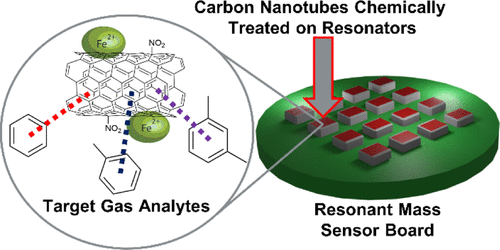当前位置:
X-MOL 学术
›
ACS Appl. Nano Mater.
›
论文详情
Our official English website, www.x-mol.net, welcomes your feedback! (Note: you will need to create a separate account there.)
Modifying the Surface Chemistry and Nanostructure of Carbon Nanotubes Facilitates the Detection of Aromatic Hydrocarbon Gases
ACS Applied Nano Materials ( IF 5.9 ) Pub Date : 2020-09-17 , DOI: 10.1021/acsanm.0c02295 John N. Hodul 1 , Allison K. Murray 2, 3 , Nikhil F. Carneiro 2, 3 , Joseph R. Meseke 2, 3 , Jacob Morris 2, 3 , Xinping He 4 , Dmitry Zemlyanov 5 , George T.-C. Chiu 2, 3 , James E. Braun 2, 3 , Jeffrey F. Rhoads 2, 3, 5 , Bryan W. Boudouris 1, 4
ACS Applied Nano Materials ( IF 5.9 ) Pub Date : 2020-09-17 , DOI: 10.1021/acsanm.0c02295 John N. Hodul 1 , Allison K. Murray 2, 3 , Nikhil F. Carneiro 2, 3 , Joseph R. Meseke 2, 3 , Jacob Morris 2, 3 , Xinping He 4 , Dmitry Zemlyanov 5 , George T.-C. Chiu 2, 3 , James E. Braun 2, 3 , Jeffrey F. Rhoads 2, 3, 5 , Bryan W. Boudouris 1, 4
Affiliation

|
The benzene, toluene, and xylene (BTX) compounds currently utilized in many building materials and paints have been linked to deleterious health effects, and thus, monitoring the presence of these compounds is of increasing importance with respect to public health. As such, there is a critical need for next-generation low-cost, selective, and sensitive indoor BTX sensors. Current BTX detection systems require multicomponent, complex devices or require high power input to achieve BTX detection at meaningful concentrations, but this long-standing paradigm can be altered through the introduction of tailored nanomaterials. Specifically, we demonstrate a selective BTX resonant mass sensor platform that leverages the unique properties of single-walled carbon nanotubes (SWCNTs) treated with hydrochloric acid (HCl) and hydroxylamine hydrochloride (HHCl), as the resultant surface chemistry and nanostructure provides specific BTX response. That is, SWCNTs are used in this case because of their high surface area that provides a robust interaction with the target gas analyte. After the SWCNTs are treated with HCl, impurities residual from the commercial synthesis of the SWCNTs are removed, which includes reducing the amount of surface iron oxide (i.e., a residual component of the catalysis used to synthesize the SWCNTs) present into iron chlorides. There is then a following HHCl treatment that leads to the reduction of iron(III)chloride to iron(II). This produces nitrous oxide gas, which provides a means to generate in-place surface functionalization of the SWCNTs; in turn, this allows for the selective adsorption of electron-dense aromatic analytes. Accordingly, these materials have selective interactions and unique responses toward each of the BTX analytes, and when these tailored nanomaterials are dropcast onto resonant devices, they provide for a chemically selective mass uptake response. In turn, this provides a clear pathway toward a practical, low-cost, efficient, and reusable sensor for BTX detection based on SWCNTs.
中文翻译:

修改碳纳米管的表面化学和纳米结构有助于检测芳烃气体
当前在许多建筑材料和涂料中使用的苯,甲苯和二甲苯(BTX)化合物与有害的健康影响有关,因此,对于公共健康而言,监测这些化合物的存在越来越重要。因此,迫切需要下一代低成本,选择性和灵敏的室内BTX传感器。当前的BTX检测系统需要多组件,复杂的设备或需要高功率输入才能在有意义的浓度下实现BTX检测,但是可以通过引入量身定制的纳米材料来改变这种长期存在的范例。具体来说,我们展示了一个选择性的BTX共振质量传感器平台,该平台利用了经过盐酸(HCl)和盐酸羟胺(HHCl)处理的单壁碳纳米管(SWCNT)的独特性能,因为所得的表面化学和纳米结构提供了特定的BTX响应。也就是说,在这种情况下使用SWCNT,因为它们的高表面积可提供与目标气体分析物的牢固相互作用。在用HCl处理SWCNT之后,去除了SWCNT商业合成中残留的杂质,这包括减少存在于氯化铁中的表面氧化铁(即,用于合成SWCNT的催化残留成分)的量。然后进行随后的HHCl处理,导致氯化铁(III)还原为铁(II)。这会产生一氧化二氮气体,这提供了一种方法来生成SWCNT的就地表面功能化;反过来,这可以选择性吸附电子致密的芳族分析物。因此,这些材料对每种BTX分析物具有选择性的相互作用和独特的响应,当这些定制的纳米材料滴铸到共振设备上时,它们提供了化学选择性的质量吸收响应。反过来,这为通向基于SWCNT的BTX检测的实用,低成本,高效且可重复使用的传感器提供了一条清晰的途径。
更新日期:2020-10-25
中文翻译:

修改碳纳米管的表面化学和纳米结构有助于检测芳烃气体
当前在许多建筑材料和涂料中使用的苯,甲苯和二甲苯(BTX)化合物与有害的健康影响有关,因此,对于公共健康而言,监测这些化合物的存在越来越重要。因此,迫切需要下一代低成本,选择性和灵敏的室内BTX传感器。当前的BTX检测系统需要多组件,复杂的设备或需要高功率输入才能在有意义的浓度下实现BTX检测,但是可以通过引入量身定制的纳米材料来改变这种长期存在的范例。具体来说,我们展示了一个选择性的BTX共振质量传感器平台,该平台利用了经过盐酸(HCl)和盐酸羟胺(HHCl)处理的单壁碳纳米管(SWCNT)的独特性能,因为所得的表面化学和纳米结构提供了特定的BTX响应。也就是说,在这种情况下使用SWCNT,因为它们的高表面积可提供与目标气体分析物的牢固相互作用。在用HCl处理SWCNT之后,去除了SWCNT商业合成中残留的杂质,这包括减少存在于氯化铁中的表面氧化铁(即,用于合成SWCNT的催化残留成分)的量。然后进行随后的HHCl处理,导致氯化铁(III)还原为铁(II)。这会产生一氧化二氮气体,这提供了一种方法来生成SWCNT的就地表面功能化;反过来,这可以选择性吸附电子致密的芳族分析物。因此,这些材料对每种BTX分析物具有选择性的相互作用和独特的响应,当这些定制的纳米材料滴铸到共振设备上时,它们提供了化学选择性的质量吸收响应。反过来,这为通向基于SWCNT的BTX检测的实用,低成本,高效且可重复使用的传感器提供了一条清晰的途径。



























 京公网安备 11010802027423号
京公网安备 11010802027423号